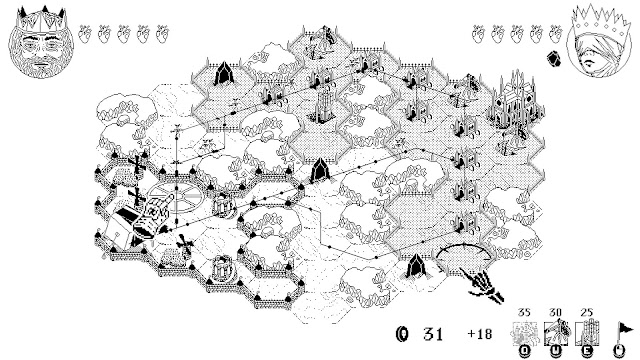Death Crown is almost unplayable on Switch, and has given me a headache every time I have tried. Consequently, this is going to be a pretty short review, and that’s a pity because I love almost everything about it.
The most immediately obvious quality about Death Crown is the aesthetic, with the game emulating the 1-bit aesthetic of the very early era, black-and-white games. There’s absolutely nothing wrong with this as an aesthetic choice. One of my favourite games of last year, World of Horror, used this aesthetic and was a gorgeous game. Death Crown uses it to great effect in cut scenes and the like, packing a lot of humour into the visual homage to the classics of yesteryear. Unfortunately, in-game, on the Nintendo Switch, the perspective is so zoomed out while individual graphical elements are also so detailed that it’s difficult to make out the action. There’s no way to zoom in for a closer look, and the game is that fast-paced that disorientation will often result in losses on higher difficulties. This is one of those cases that the developers built a thing for the PC, where the player is physically close to a monitor that is both large and of a high resolution. They then ported it to console without really considering the difference in perspective. On the relatively low resolution of the Nintendo Switch, you can barely see anything clearly, and it doesn’t get better when playing in docked mode, with the distance from the lounge to the TV.
If you can somehow work around this issue, Death Crown is a nice, streamlined strategy game. There are only a couple of buildings available (a mine for resources, a tower for defence and a barracks for units, which you direct to auto-attack enemy buildings), and the bulk of the strategy is found in making quick decisions around land control. On the map, there are three crystals that, once controlled, boost the strength of your army, and whichever side is the first to secure control of at least two of those crystals is likely to win the game.
Matches are over in just a couple of minutes – this really is fast-paced stuff – and that naturally places limits on just how much actual strategy this strategy game really features. Success is more about learning the most efficient order of construction to build up resources quickly, and then understanding what the priorities should be in terms of the order of priority for attacking the enemy (hint: go after the resources first, since, if you’re generating more resources more quickly than your opponent, you can start to overwhelm them). The speed of it does overcome a common issue with many other “light” strategy games, in that it’s over quickly for the loser (with most similar games, once one side has the advantage it’s impossible to strategise a win from behind so for the rest of the game you’re waiting for the foregone conclusion to eventuate), but the long term value isn’t there. The campaigns are fun thanks to the bits of narrative, but the skirmish mode isn’t worth much more than a play or two, because it’s not going to take long for the actual strategy to become stale.
There are a couple of different factions, but because it’s so difficult to see the action, you don’t really get to enjoy the differences between them. Between battles during the campaign, you get returned to a surrealistic campaign map to select the next battle. This is vivid art and I’d love to have prints for my wall. Unfortunately, on that main map the game also bugged out on me a few times, refusing to show the next mission options and forcing me to restart from the very beginning.
I’d love to encourage more developers to leverage 1-bit aesthetics. The high contrast and level of detail that can be worked into the art, using modern technology, makes for a distinctive and highly appealing art direction. However, it’s still got to be playable. A fast-paced strategy game that is almost impossible to follow because everything is so tiny on the screen, coupled with high levels of contrast that end up encouraging eye strain, is just not on. Death Crown would be brilliant on PC, where you can see everything that’s going on (I imagine). This lazy and ill-conceived port to the Nintendo Switch is almost worthless, sadly.









